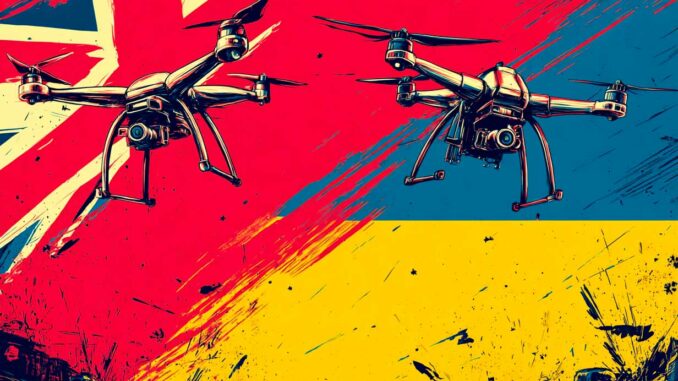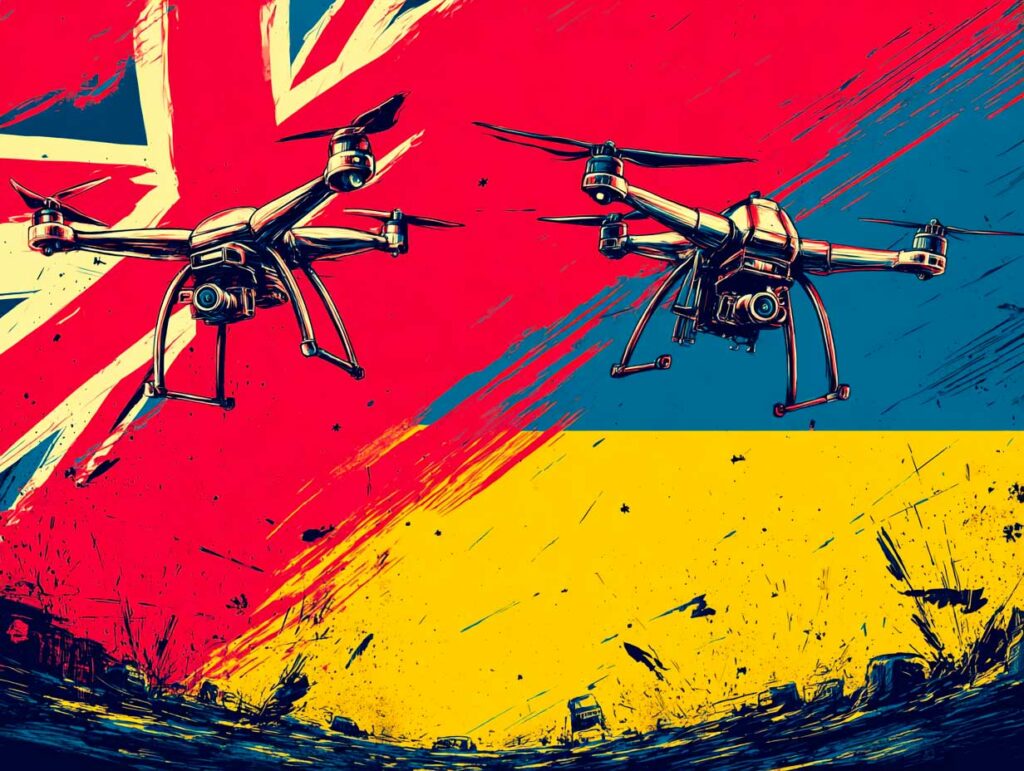
In Brussels, NATO defense ministers condemn Russian hybrid operations. The United Kingdom confirms a massive drone effort for Ukraine. Issues, figures, and implications.
In summary
Meeting in Brussels on October 15, NATO defense ministers highlighted the rise of Russian threats, from airspace violations to hybrid actions carried out via Belarus. London reiterated its goal of delivering 100,000 drones to Ukraine by the end of the fiscal year in April 2026, having already shipped more than 85,000 in the first six months of 2025. Washington urged Allies to provide more funding for assistance through the Prioritized Ukraine Requirements List (PURL), while Kyiv called for Russia to be designated a terrorist state in Euro-Atlantic forums. At the same time, NATO discussed strengthening air and anti-drone defense and harmonizing national “caveats” that hinder collective action. The aim is to speed up critical deliveries (drones, ammunition, surface-to-air systems) and to lend credibility to deterrence on the eastern flank, while discussions continue on long-range capabilities, including Tomahawk missiles.
The immediate context of the discussions
The ministerial meeting follows a series of incursions and airspace violations attributed to Russia in several EU and NATO countries. Unidentified drones have been observed flying over sensitive infrastructure, while Russian military aircraft have skirted national borders, fueling fears of a test of the Alliance’s reflexes. Warsaw, Vilnius, and Tallinn have reported separate incidents, sometimes linked to launches from Belarus. These incidents are interpreted as “below the threshold” operations combining jamming, sabotage, and aerial intimidation. Ministers therefore worked on two fronts: immediate response (patrols, air defense, counter-drone) and political-military architecture (rules of engagement, alert and information sharing).
The position of the NATO Secretary General
Secretary General Mark Rutte has emphasized that the Alliance maintains clear military superiority and will strengthen deterrence through increased investment. The agenda has focused on integrated air defense, early warning sensors, and anti-drone capabilities. The objective is twofold: to reduce the latency between detection and effect, and to fill the coverage “gaps” on the northern and northeastern flanks. NATO also encouraged bulk purchasing and standardization of ammunition to avoid the stock shortages that affected Ukraine in 2024-2025.
The UK’s drone pledge and its progress
The UK has reiterated its goal of delivering 100,000 drones to Ukraine by the end of April 2026, a significant increase from the target of 10,000 in 2024. London has earmarked £350 million specifically for this effort out of a £4.5 billion package in 2025. Operationally, the first six months of 2025 saw more than 85,000 drones deployed, bringing the effort to a pace unprecedented in Europe. The platforms include observation quadcopters, short-range loitering munitions, drop drones, and light logistics carriers. Integration is being carried out with the Ukrainian ecosystem, which assembles and modifies payloads locally and optimizes data links to limit exposure to jamming and radio detection.
The capability logic behind the acceleration
Three factors drive this volume. First, distributed lethality: inexpensive swarms overwhelm costly defenses. Second, adaptability: militarized commercial drones evolve rapidly, with iteration cycles of a few weeks. Finally, sustainability: a mix of low-cost platforms and industrial ammunition makes it possible to sustain operations over time. On the ground, Ukraine is using these drones for artillery reconnaissance, BG-BG attacks (light armor, depots, relays), and tactical night interdiction. There is therefore a constant need for volume to compensate for attrition and maintain operational pressure.
Kyiv’s priorities and the political angle
Kyiv has called on Brussels to designate Russia a terrorist state, citing strikes targeting energy, transport, and urban areas. Several European parliamentary assemblies have already adopted resolutions to this effect, although the legal classification at the executive level remains under debate. At the same time, Ukraine is calling for continued Western efforts in artillery ammunition, surface-to-air missiles, and long-range capabilities. In this regard, the discussion on cruise missiles such as the Tomahawk has resurfaced on the American side, at least under consideration, while some Allies are pushing for “European” solutions and tighter export controls to Russia and its intermediaries.
The PURL mechanism and the question of financing
On the American side, the administration has put forward PURL as a prioritization mechanism: instead of drawing directly from US stocks, the Allies finance batches of equipment produced in the United States for Ukraine. This approach aims to stabilize industrial chains and share the budgetary burden. In concrete terms, this involves multi-year commitments, advance payments, and visibility of order books. Several Nordic and Baltic countries have announced increases in their contributions; other Allies are under pressure to fill the gap.
Hybrid operations and the threat from Belarus
Ministers discussed the possibility of incursions via Belarusian relays, in the form of drones, targeted sabotage, or exploitation of migratory pressure. Belarus provides a buffer zone for low-signature actions, complicating attribution and response. The options discussed include increasing ISR (intelligence, surveillance, reconnaissance) capabilities, protecting critical infrastructure (energy, cables, hubs), and extending anti-drone bubbles around ports and airports. Neighboring states are also refining their rules of engagement against drones violating national airspace to avoid legal blind spots.
National caveats at the heart of the debate
Another sensitive issue is the harmonization of national caveats, the restrictions that govern the use of force. Substantial differences remain on the use of forces outside national territory, the neutralization of “gray” targets, and the real-time sharing of sensitive data. Ministers examined ways to reduce these differences, including pre-validated scenarios, automatic activation clauses in the event of a clear incursion, and a common technical attribution doctrine for hybrid attacks.

Air and anti-drone defense, an operational priority
In terms of capabilities, NATO is pushing for an increase in stocks of short- and medium-range surface-to-air missiles, the purchase of modular systems such as NASAMS, and the merging of radar sensors with passive optoelectronic and RF networks. European early warning projects, including “multi-static” detection architectures and AI-processed radars, aim to improve the discrimination of slow-moving threats and small radar cross-sections. On a Ukrainian scale, these building blocks translate into an “onion skin defense”: thermal cameras, directional jammers, automatic cannons, MANPADS, and then M-SHORAD SAM layers.
The figures behind the effort
For 2025, public announcements break down as follows: £4.5 billion in British aid, including £350 million for the drone segment; more than 85,000 drones delivered by London over six months; additional commitments from several Allies via PURL; and the launch of European programs to strengthen anti-drone capabilities by 2027. Ukraine, for its part, says it can produce millions of units by 2026 if funding follows, while calling for 155 mm ammunition, surface-to-air missiles, and electronic components that are resistant to jamming.
Strategic implications for the Alliance
In the short term, the goal is to prevent Moscow from exploiting regulatory and logistical “frictions.” A rapid response to drone incursions, controlled public communication, and sanctions targeting Russian supply chains are considered essential. In the medium term, NATO wants to smooth out ammunition production and standardize anti-drone training, including for partners such as Moldova, in order to curb circumvention. Finally, the discussion on long-range strikes remains open, with one red line: avoiding uncontrolled escalation while restoring the credibility of deterrence.
Points to watch in the coming weeks
Four signals will indicate whether the momentum is shifting: the actual rate of drone deliveries (per month), the signing of multi-year PURL contracts, the adoption by more states of harmonized rules of engagement against intrusive drones, and the resilience of Ukraine’s energy network as winter approaches. On the political front, it will be necessary to monitor parliamentary resolutions or statements regarding Russia’s qualification, as well as any US decision on longer-range capabilities.
The possible trajectory of Western support
If the announcements are translated into action, Kyiv will be able to maintain pressure on Russian lines, neutralize depots, and strengthen the defense of its cities against drone and missile strikes. NATO, for its part, will become more responsive to hybrid operations, particularly on its northern flank. Conversely, a delay in funding or fragmentation of engagement standards would recreate windows of opportunity for Russia and its proxies, with the risk of serious incidents at the borders. The window of adjustment is now open, at the crossroads of the defense industry, political cohesion, and the resilience of European societies.
War Wings Daily is an independant magazine.